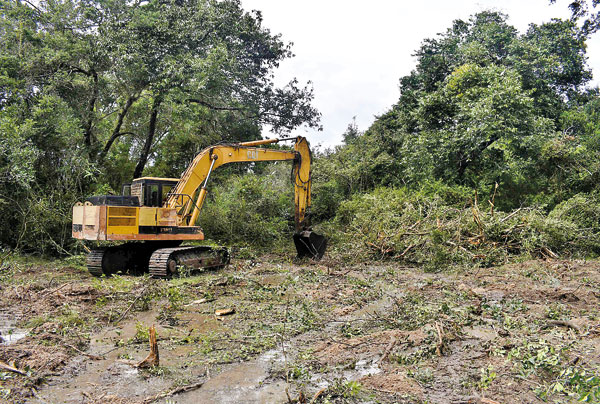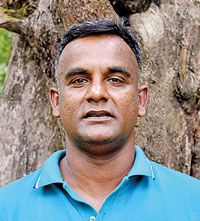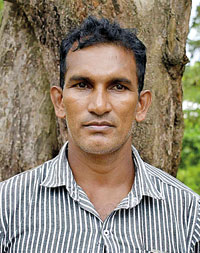News
Axe on Welikanda forests: Destruction or development?
View(s):- Environmentalists and residents up in arms over clearing of forest reserve for maize cultivation
- Say the ecosystem is being harmed and human-elephant conflict aggravated
- NLDB chief rebuffs allegations; says the forest was once agricultural land that even had milk factories
- Farmer alleges treasure hunting in plots given to businessmen; claims archaeological sites being destroyed
By Tharushi Weerasinghe
Large swathes of forest are being cleared in the Thrikonamadu Forest Reserve in the Polonnaruwa district’s Welikanda area for farming — and allegedly for treasure hunting — despite protests from environmentalists and villagers.
Residents, who are on the receiving end of the worsening human-elephant conflict issues, worry that the clearing will exacerbate their plight. They are angry that thick forests protected by them during decades of war are now being razed down by companies on the pretense of maize farming.
It is said some 1,500 acres of forests have been given on bond to various companies which have begun planting maize after clearing the area.
The Sunday Times visited the area on Tuesday to verify the allegation. Welcoming us were barren lands that lay muddied to the point of sinking from the rains that day, instead of the trees that had stood there before. Through a broken elephant wire fence, knee-deep in the mud, we walked onto a plot where tractors were raking up the ground as companies began to sow their seed.
A court order to stay the clearing had come the day before but locals said a news channel had broadcast that this was to be a “temporary stop”. As our team went further in, the thuds of backhoes hitting tree trunks permeated the forest. The moment the cameras and the crew came within the backhoe operators’ sight, they dashed. The equipment was still hot when we arrived at the newly cleared area where only a few trees had been left, with their lifespan extended by half an hour or so, thanks to our presence.
Leading the investigation into the woods was Policy and Advocacy Campaign Officer of the Centre for Environmental Justice Janake Withanage. “This is the corridor for about 400 elephants travelling from Maduru Oya to Somavathiya Reservoir, Kaudulla, and Wasgamuwa. Elephants are always around,” he told the media.
Some 29 businesses had been given 50-acre plots each under a programme of the National Livestock Development Board. The plots were handed over to them following a gazette notification from the Mahaweli Development Authority. They have cleared the forest using bulldozers to begin commercial cultivation of maize for animal fodder, the environmentalist said.
“But across Sri Lanka, there are vast areas of land that can only be used for agriculture. Yet here they are devastating important and complex ecosystems needlessly,” he said.
“The human-elephant conflict (HEC) in Welikanda is so acute that even the walls outside the local Police Station and hospital have been destroyed by elephants in the night. At the rate the HEC is aggravating, people will have to abandon their homes soon,” Mr. Withanage said, noting that the CEJ would go to courts to stop this destruction, if necessary.

Clearing of the forest continues: The backhoe operator fled as we approached the area
But officials claim these lands have always been farms. The Kandakadu and Thrikonamadu farms, spanning over 12000 acres existed in this land that belonged to the Agriculture Ministry, claimed National Livestock Development Board (NLDB) Chairman Prof. H.W. Cyril.
According to him, in the 1970s, there were milk factories in the area. The land was later given to the Health Department for animal production and, after that, to the NLDB. During the war, the area came under the LTTE’s control. After the security forces liberated the area, the army set up a camp there, Prof. Cyril said.
“These lands were later brought under the Mahaweli Development Board which then reallocated the farms to us,” he said.

Environmentalist Janake Withanage continuing a probe on the project
Commenting on the elephant corridor issue, he said a strip of the area surveyed by the Mahaweli Development Board had been demarcated as a protected area on the advice of the Wildlife Ministry. Prof. Cyril insisted that development work was happening on land outside the reserve and buffer zone. He said the trees in the forest would be about 30 years old at most and added that it was the bush areas that were being cleared.
The NLDB chairman said the companies that had been given the land had been instructed not to cut certain trees.
After the Sunday Times pointed out that these trees had been cut down last Tuesday and that trunks of Veera, Burutha, and Palu trees lay across the forest floor, on Friday, an NLDB team led by Prof. Cyril headed in for inspections.
“The lands being used do not fall within the reserve area,” claimed Welikanda Divisional Secretary M.M. Khairunnisha. She acknowledged the HEC was a huge problem to the area people and a primary concern for those protesting the forest area being cleared out. She said she would meet other government officials next week to explore how best to manage the situation.
But residents told us a different story. “We have been farming here for generations and everyone knows that the first step when you farm in an elephant-populated area is to erect a proper fence,” noted farmer Ajith Gihan.
He was among other residents who claimed that farming was a farce put up by treasure hunters. “The area is of archaeological value and stories abound of treasures and artefacts being buried in this land by ancient kings,” he said.
But the NLDB chairman claimed that the archaeological sites had been excluded from the allotted land plots.
Mr. Gihan said: “This is forest destruction and it’s so sad because these areas were better protected during the war.”
He also said the pattern of destruction was boxing the elephant populations into the middle of their areas instead of driving them out from one side to the next through a systematic clearing of the forest. “Three people have already died; so we can’t even imagine what the implications of this project are going to be,” he said.

Farmer Ajith Gihan says maize farming is a farce
“This government can’t even afford a Panadol pill. Can it import oxygen for our children,” Ven. Dimbulagala Rahulankara Thera of the Welikanda Susirigama Sri Sudarshanaramaya, said, referring to the importance of trees as a source of life-sustaining gas. He alleged the government had no master plans to protect the ecosystem.
As of now Sri Lanka’s annual deforestation stands at 100,000 acres – “but these numbers are abysmally incomplete,” Convener of the Rainforest Protectors, Jayantha Wijesinghe told the Sunday Times. As of now they themselves are dealing with 260,000 acres’ worth of forest in deforestation cases
The best way to say that you found the home of your dreams is by finding it on Hitad.lk. We have listings for apartments for sale or rent in Sri Lanka, no matter what locale you're looking for! Whether you live in Colombo, Galle, Kandy, Matara, Jaffna and more - we've got them all!

